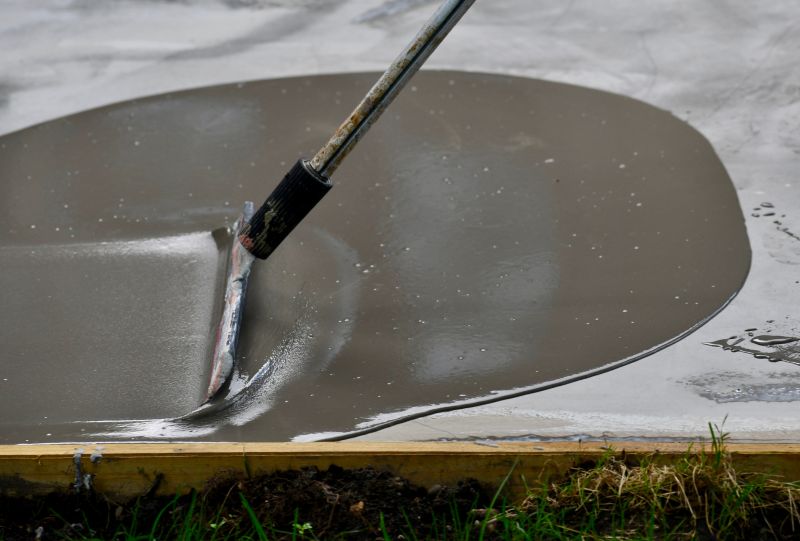Favorite Tools For Concrete Overlay Service Professionals
Equip yourself with trusted products that simplify application and improve the longevity of concrete overlays.
 Concrete overlay services are an effective way to enhance the appearance and durability of existing concrete surfaces. These services involve applying a thin layer of specialized material over the existing concrete to create a fresh, smooth, and uniform surface. This process is often used to cover up cracks, stains, or surface imperfections, providing a renewed look without the need for complete removal and replacement. The success of a concrete overlay depends heavily on the quality of materials used, surface preparation, and application techniques.
Concrete overlay services are an effective way to enhance the appearance and durability of existing concrete surfaces. These services involve applying a thin layer of specialized material over the existing concrete to create a fresh, smooth, and uniform surface. This process is often used to cover up cracks, stains, or surface imperfections, providing a renewed look without the need for complete removal and replacement. The success of a concrete overlay depends heavily on the quality of materials used, surface preparation, and application techniques.
Top Overall Option
Concrete Overlay Bonding Primer
A high-quality bonding primer designed to improve adhesion between existing concrete surfaces and overlay materials. It helps create a strong, durable bond, reducing the risk of delamination or cracking. Suitable for various overlay products, this primer is a versatile choice for both professionals and DIYers aiming for a smooth, long-lasting finish.
Types of Products For Concrete Overlay Service
Polymer-Modified Overlay Toppings
Flexible and durable toppings that incorporate polymers for enhanced adhesion and crack resistance, ideal for decorative finishes.
Stamped Overlay Kits
Pre-designed overlay kits that allow for textured, stamped patterns to mimic stone, brick, or tile surfaces.
Colored Concrete Overlays
Overlay products with integrated pigments or colorants to add vibrant hues and aesthetic appeal.
Self-Leveling Overlay Compounds
Fluid overlays that spread evenly to create a smooth, level surface suitable for high-traffic areas.
Textured Finish Overlays
Products designed to add tactile textures such as broom finish, stippling, or stamped patterns.
Polyurea Coatings
Fast-curing, flexible coatings that provide a seamless, protective layer over overlays.
Acrylic Overlay Sealers
Clear sealers that enhance the appearance and provide protective barriers against stains and wear.
Epoxy Overlay Systems
High-performance epoxy products for creating durable, glossy finishes on concrete overlays.
Resin-Based Overlay Coatings
Resin formulations that offer high adhesion and chemical resistance for decorative overlays.
Crack-Resistant Overlay Mixes
Specialized mixes formulated to accommodate slight movements and reduce cracking in overlays.
Anti-Slip Additives
Additives that can be mixed into overlay materials to improve traction and safety.
Concrete Surface Cleaners
Products used to thoroughly clean and prepare existing surfaces before overlay application.
Bonding Agents
Adhesive products that improve the bond between existing concrete and overlay materials.
Protective Sealers
Sealants that protect overlays from stains, moisture, and wear, extending their lifespan.
Popular Choices
Widely used for their flexibility and durability, these overlays help create versatile decorative finishes.
Popular for adding textured, patterned designs that mimic natural materials with ease.
Preferred for their ability to add vibrant colors and customization options to concrete surfaces.
Favored for creating smooth, even surfaces in various setting types.
Commonly used to enhance appearance and provide a protective finish.
Popular for their high durability and glossy finish in commercial and residential applications.
Chosen for their chemical resistance and aesthetic flexibility.
Valued for their ability to accommodate slight movements and reduce surface cracking.
Popular for extending the lifespan and maintaining the appearance of overlays.
Often added to overlays for safety in high-traffic or outdoor areas.
For professionals and DIY enthusiasts alike, selecting the right products for concrete overlay is crucial. From bonding agents and primers to decorative toppings and sealers, a wide variety of products are available to suit different project needs. Properly chosen products can improve adhesion, enhance aesthetic appeal, and extend the lifespan of the overlay. It is important to consider the specific surface conditions, environmental factors, and desired finish when choosing these products.
The application process typically involves cleaning and preparing the existing surface, applying bonding agents or primers, and then spreading the overlay material evenly. Decorative options such as stamped overlays, colored overlays, or textured finishes can add visual interest to concrete surfaces. Sealers and protective coatings are often applied afterward to safeguard the overlay against wear, stains, and weathering, ensuring long-term performance.
Whether for residential driveways, patios, commercial floors, or decorative pathways, the right set of products can make a significant difference in achieving a professional-looking result. Quality products designed specifically for concrete overlays help ensure proper adhesion, durability, and aesthetic flexibility. By understanding the different product options and their specific uses, users can make informed decisions to meet their project goals effectively.
Key Buying Considerations
- Compatibility with existing concrete surface to ensure proper adhesion.
- Type of overlay material suited for the intended aesthetic and functional outcome.
- Environmental conditions such as moisture, temperature, and exposure to elements.
- Ease of application, including required tools and surface preparation steps.
- Drying and curing times to plan project timelines effectively.
- Durability and resistance to cracking, staining, and wear over time.
- Finish options including textured, smooth, stamped, or colored surfaces.
- Availability of protective sealers or topcoats for added longevity.
- Compatibility with decorative techniques like stamping or coloring.
- Budget considerations, balancing quality and cost.
- Professional installation versus DIY application requirements.
- Surface preparation needs, such as cleaning, repairing cracks, or leveling.
- Product safety and handling instructions.
- Long-term maintenance requirements for the overlay finish.
- Availability of technical support or customer service from suppliers.
This content contains affiliate links and we may earn a commission from qualifying purchases to support our work.
